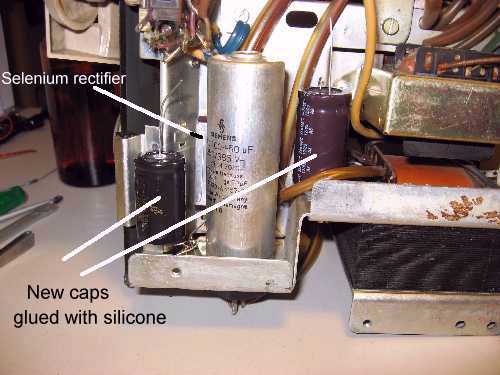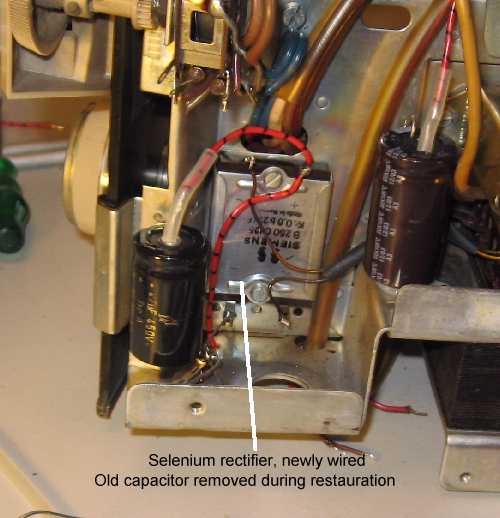telefunken: 8; Gavotte
telefunken: 8; Gavotte
hello. i'm doing my first recap of a telefunken gavotte 8u. do i need to remove the cover of the fm rf sub chassis to replace any of the capacitors inside? if so, how do i remove the cover? there appear to be two small nuts under the chassis. do i remove those to remove the cover? if there's nothing inside i need to replace or test routinely, perhaps i'll leave it alone.
also, what is the advisability of replacing the selenium rectifier(s) with solid-state rectifier diodes?
thank you. happy holidays. all best...
charles
p.s. i wanted to add that i currently own 2 unrefurbished gavottes (8u and 9) and i owned another in the early 1970s, and i've always been so impressed with the well-balanced, beautiful sound of these middle-value radios. i've always owned the types with the bass, solo, soft and jazz button tone controls, and have been very pleased with what they do.
To thank the Author because you find the post helpful or well done.
First steps ...

Dear Charles,
I do not know your technical knowledge/background. It seems to me that you should read this , including references and attachements; and that, especially post No 6 from Mr Erb (The "quick and dirty"-method).
Not only Mr Knoll's or Mr Erb's but also my general advice for you is:
- Do not repair or restore anything if it is not really necessary !
- Do not change parts "globally" ("Recapping") !
- Always change only one single component to time and carry out a test after each replacement to verify that the component is faulty or not. If not, you should mount it again in the exact same manner and accurately at the old location.
- Do not open UKW/FM casings ! If the unit is working, you have no reason to do so.
The replacement of selenium rectifiers depends roughly speaking upon the fact wether it is working or not. If it works, you may leave it inside. But if you observe the typical burnt smell of selenium, then you must replace it.
Please excuse my clear words, but I think they were necessary. And thank you for understanding.
Rolf
To thank the Author because you find the post helpful or well done.

Rolf gives excellent advice. I would add to this: take pictures. Take lots and lots of pictures before you disturb anything. This will save you uncountable grief later on. Even if you think you'll remember where the green wire went or which terminal was the positive, eventually you'll get distracted by something else and the radio you were going to get to tomorrow won't be revisited until next month or next year. Good digital cameras now cost less than a halfway decent oscilloscope or VTVM, and I'd consider them to be at least as essential equipment to radio repair.
As far as the selenium rectifier question, my personal preference is to leave it alone if it's still working. I have two receivers with such devices that have been in continuous operation for nearly 50 years. If they're not abused, they tend to be pretty reliable. If they croak, you'll know it!
To thank the Author because you find the post helpful or well done.
muchas gracias!
rolf:
thank you for taking your time to answer my query. i've not a leg to stand on, and debating anyone with your knowledge of the art of electronic design would compare to me challenging anne-sophie mutter to a fiddle-playing contest (i, who have never even held a violin!). here, in america, radio forums routinely stress the importance of replacing old paper capacitors, and horror stories are rife about the horrors of failing selenium rectifiers, perhaps in an open condition, with reverse leakage that can destroy output valves and/or transformers (in addition to the awful smell of burning selenium).
my concern is not to tinker for the sake of tinkering, but to attempt to recover FIDELITY. of course, by that i mean the true sound of a symphony orchestra playing over a strong FM broadcast signal that has been processed by a fine german radio, whose designers i hold in the highest esteem. i have recently acquired a telefunken opus 6 and a gavotte 8u whose fidelity troubles me. i've also bought a braun with the super rc61 chassis that just sounds tinny and terrible. i'm sure these radios were not designed nor built this way more than 50 years ago. i thought that replacing old, leaky paper caps would make a start toward recovering the wonderful sound that was so meticulously designed into these machines.
believe me, i am happy to leave these handsome akg selenium rectifiers alone! it's been strongly suggested to me that bypassing these "black towers" with 1N4007 diodes in series with the proper dropping resistors is a good and inexpensive safety move. but, again, i'm happy to skip that chore, if you recommend it.
as an aside, i did read "Restaurieren von GRUNDIG Geraten by the wonderful herr professor hans m. knoll, but i sorely missed the very gifted language translation of thomas albrecht; strict word-for-word translation of german to english is quite difficult to read and nearly impossible to understand by this english-speaking american, whereas herr knoll's thoughts come through crystal-clear with mr. albrecht's translations, and that is a generous gift to the members of herr erb's very important, robust and growing web site.
ms. denber: i'm very happy to see you here, and to read your contributions. please know that i put my rather extensive collection of digital nikon camera, lenses, meters, lighting equipment, etc., to use as i plod through the learning process of preserving my aging, beloved german radios. like hansel and gretel, i try thus to mark my path as i begin to grasp the importance of keeping components where they were placed in the original designs (even to the use of proper wire gauges and types), while leaving no bread crumbs inside my radios. i was fascinated to read a lengthy thread about antenna stubs, their designs and the apparent intents of the designers. that thread was richly enhanced for us english-speakers by the beautiful german/english translation efforts of mr. thomas albrecht. i think there's nothing in these radios that doesn't need to be here, and few components that weren't placed to pull every possible atom of clean radio power from the components approved for use.
all this is meant as a thank-you, and an assurance that your advice is heard and heeded.
all best to you in this holiday season, and warm greetings from the snowy rocky mountains of america.
-- charles jones
P.S. i want to add that, while i have complained of the lack of fidelity of two of my telefunkens, i also own a grundig musikschrank 7068, the fidelity of which is superb (with the exception of two dead tweeters of the flat, square brown grundig type). i've brought several other types of german electrostatic tweeters back to life by dismantling them, cleaning out the decomposed foam, replacing that foam, making a good connection to the membrane and reassembling, though i've never attempted a repair of this grundig type. mein gott, the crossover attentions in the speaker array is nothing short of awsome! i'll have to move this beautiful musikschrank away from the wall and fall to my aging knees to begin this needed repair. (i'll add that i am quite impressed by the wunschklang battery of tone controls--and i understand there is a paper on this, though it is in german and would do me no good, unless i learned the language of bach and beethoven.) and, alas, the perpetuum-ebner rex A turntable needs new belts and other attentions. but what a wunderbar radio! and what a pleasure to listen to!
again, all best to you...
To thank the Author because you find the post helpful or well done.
How to ...

Dear Michelle,
thank you very much for your great support, you expressed exactly what I tried to explain, especially the documentation with figures and photos ! Later on I discussed my answer with my wife whether it was too much resolute or not. We came to the conclusion that it was yet acceptable.
Dear Charles,
thank you for understanding. I never intended to be impolite or arrogant. Enjoy your radios, their sound and shape, whenever possible ! After work and at home, my first action is very often to switch on one of my old radios or amplifiers and, after warming up of the tubes, to hear classical music while looking through my mail.
I searched RM.org in order to find out more details about selenium rectifiers, some results are in German language only.
Please have a look at these articles in English language, perhaps Selen-Gleichrichter, post 7 (Hr. Zirke), or Ersatz (Replacement) durch Si-Gleichrichter, posts 3 and 5 (Hr. Roschy), and, most important, operational safety of your equipment (post 1, Hr. Grund).
In general, always try to find out and (learn) to use the schematic of your equipment. One of the first steps is to measure the supply voltage/s at the electrolytic capacitor/s following the rectifier. Lord Kelvin said "If you cannot measure anything your knowledge about your device is very poor". A voltage difference of 10 or 15 per cent in comparison with the values given in the schematic seems permissible, but not more. If you are then convinced that replacement is necessary you may use a Si-bridge for this purpose. In my example below I only added two new caps and continued the use of the old rectifier.


If you want additionally to care for the outer shape of your equipment you can try to hide this little new component inside of the empty casing of the old rectifier, similiar as I did this here with old electrolytic capacitors. If this is not possible or difficult (danger of short-circuit) because of a flat type like that in my photo you can glue it with transparent sanitary silicone near the old part and connect it with the wires from the transfomer and the first power supply capacitor respectively. Horror scenarios may be popular, but we can avoid such situations by sytematically working in order to achieve operational safety.
Best regards and good luck !
Rolf
To thank the Author because you find the post helpful or well done.
thank you, rolf
your work is quite beautiful. please know i received your advice gratefully and in no way found it impolite or arrogant. i was afraid that no one would answer my posted question. of course, job-one is that i must learn to measure, per lord k. and so i read and acquire modest tools. a good portion of my reading is done here at RMorg. thank you again for your input. (that's a beautiful parrot you have).
charles
To thank the Author because you find the post helpful or well done.

Before going forward, check out Paul's thread,
http://www.radiomuseum.org/forum/grundig_5088_usa_componant_and_alignment_questions.html
My experience with vintage fifties and sixties German radios contrasts Rolf's, in that, I find that I must replace ALL capacitors (paper and electrolytic) because of the storage environment most of these radios experienced in North America.
My impression is, these radios were too valued by the owners to throw away, but since they stopped working, were placed in the garage or basement. If you are familiar with paper degradation because of acids contained in the paper, the humidity took its toll on the paper capacitors!
As for the electrolytics, they're similar to batteries, after awhile, the internal chemistry goes south.
In unusual circumstances, when the radio was in regular use the last fifty years, there is a possibility that the radio might be able keep most of its components. Considering my luck in Vegas and the lottery, I'll pass on the gamble!
Omer
To thank the Author because you find the post helpful or well done.
So true!
omer:
that has been exactly what i've found here in the U.S. the german radios i've run across here today are far, far from daily users (unlike so many in europe). german monophonic hi-fi radios fell by the wayside with the popularity in the u.s. of stereo components, which "caught fire" here in the '60s. also, in the late 1950s and '60s, about the only thing available on fm (ukw) in the u.s. then was classical music, and that u.s. audience was tiny, as most americans were listening to "top 40" am (mw) radio in their cars and on their transistor rados and "all-american 5" tabletop tube radios, and to the 45 rpm records made popular by that am (mw) medium. so, the venerable german, austrian, bavarian and dutch radios in use here (primarily brought here by soldaten) were put away or used as decorative items in the home. mostly, they have sat for decades in basements, garages, sheds (and worse) attics. one radio i recently bought must have been stored in a barn. i find bulging, sweating wax-coated paper capacitors and leaky electrolytic caps installed throughout many of these older radios that i couldn't possibly trust. (and i wonder what decades of dry heat and dust does to the quality of these once-great german loudspeakers. such storage certainly does no good for wiring systems). of course, such storage also does great damage to the once-fine finishes of the cases of these radios. were i rich, i'd buy my radios in europe, bring them home, plug them in and enjoy them, and not have to worry about the intensive labor and the cost that goes into refurbishing the examples we have here in the u.s.
To thank the Author because you find the post helpful or well done.